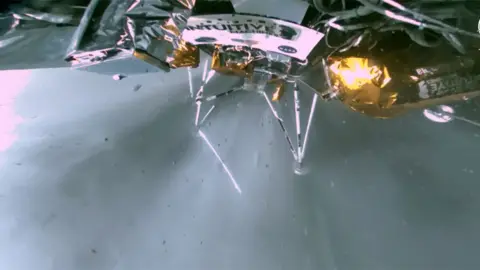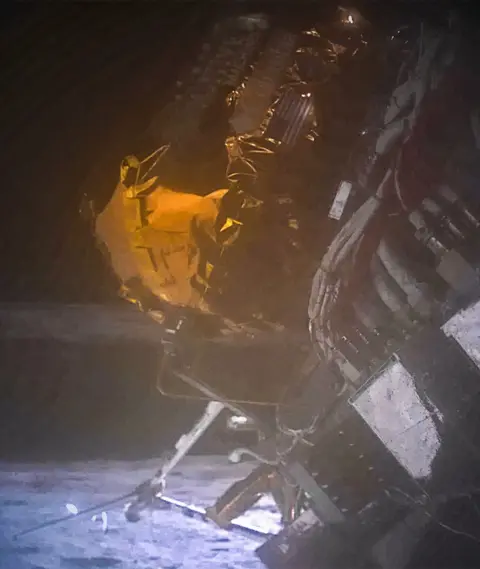By Jonathan Amos@BBCAmos
 Intuitive Machines
Intuitive MachinesThe first clear images of the Odysseus robot on the surface of the Moon have just been released.
They include a view of the American mission lying to one side, having broken a leg on touchdown.
The spacecraft continued to work afterwards, however, sending back data about the lunar environment.
Odysseus made history last Thursday by becoming the first ever privately built vehicle to complete a soft landing on the Moon.
And despite the awkward orientation it eventually adopted, the robot should be celebrated, said US space agency administrator Bill Nelson.
Nasa had contracted the operating company, Houston-based Intuitive Machines, to carry six scientific instruments on board the lander.
"Odysseus is a success," the agency chief told reporters. "We are in the sixth day of what was planned as an eight-day mission, and we're still receiving data from those instruments."
 Intuitive Machines
Intuitive MachinesOdysseus' descent, clearly, was a little hairy.
The robot was supposed to come straight down, vertically, with a speed of one metre per second.
In the event, it had navigation issues whereby the onboard computer couldn't process precise laser range-finding data fast enough and had to rely solely on optical cameras for altitude and velocity information.
It meant the craft actually came in three times faster than it should have, and with an element of sideways movement that resulted in a skid.
"The landing gear took the bulk of the load and we broke one or two possibly landing gear," explained Steve Altemus, IM's CEO and co-founder.
"We sat there upright with the engine firing for a period of time. And then, as it wound down, the vehicle just gently tipped over, and in our simulation with 1/6 gravity, we showed that it took about two seconds."
Odysseus is thought to be resting on one of its yellow helium pressure tanks at an angle to the surface of roughly 30 degrees.
The craft was forced to communicate with Houston via its low-gain antennas. But once controllers got the hang of how the signals were being sent, a broad data stream was established.
 Intuitive Machines
Intuitive MachinesNasa's six instruments were focused on testing new navigation technologies and studying the surface conditions at the landing site.
Susan Lederer, who oversaw all the experiments, said the agency teams and IM staff worked side by side to make the mission a success.
"We were collaboratively working together to find solutions so that the spacecraft could live and the payloads could get their data," she told reporters.
"We went from basically a cocktail straw of data coming back to a boba tea-sized (very large) straw of data coming back."
The robot is expected to go into hibernation on Thursday at the latest.
Because of the way its solar cells are pointing, they're going to lose sight of the Sun and that will deny the battery of charge.
And, in any case, the Sun will soon disappear over the horizon. Only when it returns in mid-March will engineers have a chance of reviving Odysseus.
"We'll start listening at sunrise at our location and see if 'Oddie' wakes up from a nap," said Tim Crain, IM's CTO and co-founder.
Susan Lederer said she wouldn't bet against the "scrappy little dude" re-establishing contact.
 Intuitive Machines
Intuitive MachinesThe Intuitive Machines mission is part of Nasa's Commercial Lunar Payload Services (CLPS) programme, in which the agency is paying various private American companies for cargo services to the Moon.
These companies are responsible for designing, building and operating their robot landers - Nasa is a payload customer.
A whole series of robotic "scouts" is planned as the agency works towards returning astronauts to the Moon's surface later this decade.
Nasa regards the CLPS approach as a more economical way of getting its science done, while at the same time seeding what it hopes will become a thriving lunar economy.
Intuitive Machines has two further missions in prospect for 2024. The next will see a robot drill into the surface.
"We've kicked open the door for a robust thriving cislunar economy in the future. That's compelling," said Steve Altemus.
"I think this CLPS experiment, this first landing, the success on the Moon for first time (by the US) in 52 years, is really a point in history that we should celebrate."
Earlier this week, the Japanese space agency managed to wake its Slim lander after it had gone through a "lunar night".
The Jaxa robot had also touched down in an awkward fashion - on its nose. But like Odysseus, this didn't stop it functioning, and it was able to send back many pictures of its surroundings.
 JAXA
JAXAhttps://news.google.com/rss/articles/CBMiNWh0dHBzOi8vd3d3LmJiYy5jb20vbmV3cy9zY2llbmNlLWVudmlyb25tZW50LTY4NDI1MjEx0gE5aHR0cHM6Ly93d3cuYmJjLmNvbS9uZXdzL3NjaWVuY2UtZW52aXJvbm1lbnQtNjg0MjUyMTEuYW1w?oc=5
2024-02-29 14:43:27Z
CBMiNWh0dHBzOi8vd3d3LmJiYy5jb20vbmV3cy9zY2llbmNlLWVudmlyb25tZW50LTY4NDI1MjEx0gE5aHR0cHM6Ly93d3cuYmJjLmNvbS9uZXdzL3NjaWVuY2UtZW52aXJvbm1lbnQtNjg0MjUyMTEuYW1w














